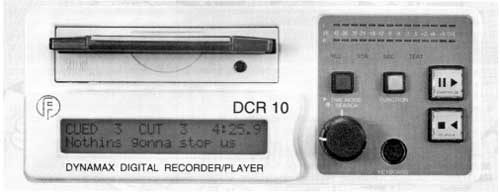
by Jerry Vigil
As the rapid conversion from analog to digital continues throughout the radio industry, no single format has yet to surface as the official replacement for carts and cart machines. But it’s evident that stations are choosing either the large digital delivery systems which store all audio on huge hidden disk drives, or they’re opting for systems that store the audio on things you can hold in your hand, like MiniDiscs, Zip, or Jaz disks. The latter choice keeps things on somewhat familiar ground, and for some, eliminates the fear of losing ALL commercials in the event of a disk or computer crash (although systems of this type offer substantial backup options). For the station that prefers to keep the familiarity and functionality of carts but wants to move to the digital age, the Dynamax DCR 10 may well be the perfect choice.
The DCR 10 is the sequel to Fidelipac’s first digital cart machine, the DCR 1000 [July 1992 RAP Test Drive]. The DCR 10 takes many of the features of the DCR 1000 and adds more to the package, using recent technology to fully update the earlier model. And disks recorded on the older DCR 1000 system are compatible with the DCR 10—a nice break for anyone using the previous system and wanting to upgrade to the DCR 10 without having to re-record everything. Another upgrade option is to update existing DCR 1000s with the DCR 10 drives and software, basically turning your DCR 1000s into DCR 10s.
Go Configure
The DCR 10 is available in several different configurations. The standard model comes with a 2 megabyte floppy drive. This drive uses standard 3 1/2-inch floppy disks specially formatted to 2MB and is ideal for putting single items on a single disk, much like using a 70-second cart. You also get the luxury of very inexpensive disks available at your nearby computer or office supply store. The DCR 10 can also be configured with a 100MB Zip drive, providing roughly 50 times more recording time. Magneto Optical drives are also available in 230MB and 640MB sizes.
Recording times depend upon a couple of things. The standard model that ships with the 2MB drive offers sampling rates of 22.05kHz, 25.76kHz, and 32kHz, and the DCR 10 uses APTX data compression at a 4:1 ratio. So, a 2MB floppy, at 22.05kHz sampling, yields one minute and fourteen seconds of stereo recording time or about two and one half minutes in mono. The high frequency response at this rate is about 10kHz which is sufficient for voice work and many sound effects but isn’t enough for material with music or high quality sound effects. The DCR 10 includes an odd sampling rate of 25.76kHz in order to get 1:03 recording time on a 2MB floppy, just enough to handle those sixty second spots at the best quality you can put on a 2MB disk. You can hear the difference between 25.76kHz and 32kHz, but for commercials, especially those delivered to stations on high-speed duplicated reels, the difference is negligible. For broadcast, the 32kHz sampling rate is the highest you need, offering a frequency response of 20-16kHz and yielding :51 of recording time on a 2MB disk, perfect for jingles, IDs, promos, and other short program material. Up to 16 cuts can be placed on the 2MB disk.
The 100MB Zip drives obviously increase recording time considerably over the 2MB disks. The inexpensive Zip disks are ideal for storing libraries of IDs, music beds, and sound effects. A single Zip disk will hold over 52 minutes of stereo 32kHz audio. The MO drives kick recording time into hours. A 640MB disk will hold over 5 1/2 hours of stereo 32kHz audio! And both Zip and MO disks can store up to 99 cuts per disk.
And for the audio purist, you’re not limited to 32kHz sampling. Order your DCR 10 with the DCR-44/48K upgrade option to get the full spectrum of common sampling frequencies. And if the APTX data compression bothers you, order the DCR 10 with the DCR-L option for linear, uncompressed recording. Of course, you’ll probably rule out the 2MB disks for anything other than short IDs and such and will need the Zip disks for commercial length cuts. Other options include the DCR-D I/O upgrade, which adds digital I/O along with the 44.1 and 48kHz sampling rates mentioned earlier.

